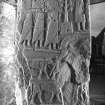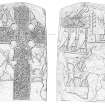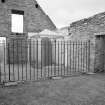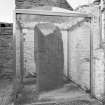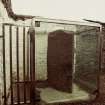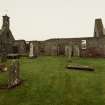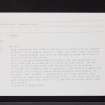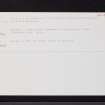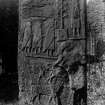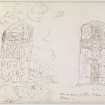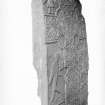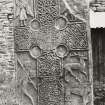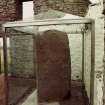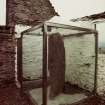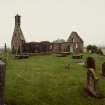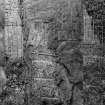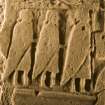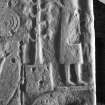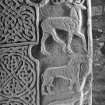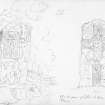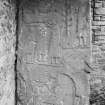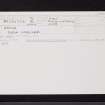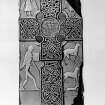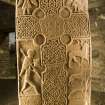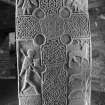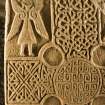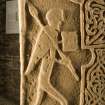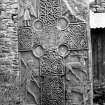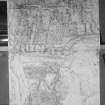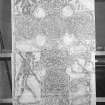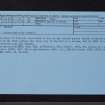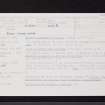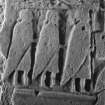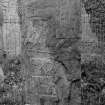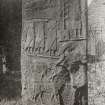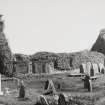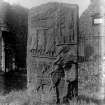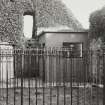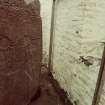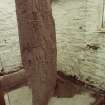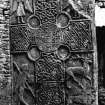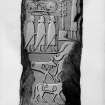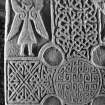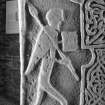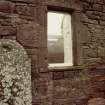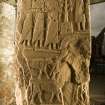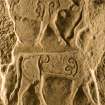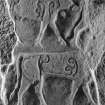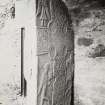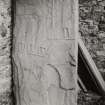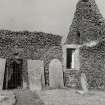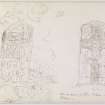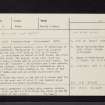Eassie
Cross Slab (Pictish), Pictish Symbol Stone (Pictish)
Site Name Eassie
Classification Cross Slab (Pictish), Pictish Symbol Stone (Pictish)
Alternative Name(s) Eassie Old Church; Eassie, Old Parish Church; Eassie Old Kirk
Canmore ID 32092
Site Number NO34NE 4
NGR NO 35258 47449
Datum OSGB36 - NGR
Permalink http://canmore.org.uk/site/32092
- Council Angus
- Parish Eassie And Nevay
- Former Region Tayside
- Former District Angus
- Former County Angus
Eassie (St Brandon), Angus, Pictish cross-slab
Measurements: H 2.03m, W 1.02m, D 0.23m
Stone type: Old Red Sandstone
Place of discovery: NO 3526 4745
Present location: in a glass shelter in the ruined church.
Evidence for discovery: found in the bed of a stream near the church in the late 18th century and erected at the east end of the ruined church by around 1830.
Present condition: weathered and damaged, especially on face C.
Description
This is an imposing slab with a low pedimented top and relief carving on both broad faces. Face A is filled with an equal-armed cross with rectangular terminals set on a shaft, the whole outlined with a roll moulding. The armpits are closed and circular, and there is a roundel at the centre of the cross-head. The arms and shaft are filled with interlace and the roundel with key pattern. On either side of the upper arm is a double-winged angel with spiral joints to the wings. Below the side-arm on the left-hand side is a warrior striding towards the cross, armed with spear over his right shoulder and a square shield held in his left hand. The shield is very small and likely to be a fist shield or buckler for close combat (Ritchie 1969, 39). Apart from a short cloak streaming out behind him, the warrior appears to be naked. To the right of the shaft is a stag, oddly posed with its right hind leg and right foreleg touching. Below is a quadruped with clawed paws and below again a hound.
On the upper part of face C, and separate from the lower part by roll mouldings, are a Pictish beast and an elaborately ornamented double disc and Z-rod above three warriors in tunics and long cloaks, the foremost of whom is slightly larger than the rest. Each of the bearded warriors carries a long spear with leaf-shaped head in front of him and their hair falls to a roll on their shoulders. To their right and at a slightly higher level is an apple tree in a square pot and a figure in a tunic with a club over the right shoulder and a round object, perhaps an apple, hanging from the left hand. The rest of the right-hand side of face C is badly damaged, and it is difficult to identify what was carved beneath the tree and the figure. Mack suggested an arch over a Pictish beast, a combination familiar from elsewhere, but what resembles the hind leg of a beast, ending in a scroll, is carefully carved as if broken off the arched object above. There are traces of spiral ornament within the arch. Below are at least three cows, the top one on the left with a curving horn and a bell at the neck. All the figures and cows are moving towards the right.
Date range: eighth century.
References: Chalmers 1848, pl 16; ECMS, pt 3, 218-19; Fraser 2008, no 58.
Desk-based information compiled by A Ritchie 2017.
NO34NE 4 3526 4745
For Eassie, Old Parish church, see NO34NE 3.
(NO 3526 4745) Standing Stone (Sculptured) (NAT)
OS 6" map (1959)
An upright, symbol-bearing, Class II cross-slab of old red sandstone, rectangular in shape but slightly pointed at the top, 6'8" high by 3'4" by 9" thick.
It is sculptured in relief on both faces, the front bearing the cross, two angels, a man with spear and shield, a stag, a hound and a unidentifiable beast. The back bears the 'elephant', double-disc and Z-rod symbols, four human figures, three of them in procession, and a pot with a flower or tree growing in it. Parts of the bodies of three cows and an arched object have been broken away.
The stone was found in the bed of a stream near the church, to the east end of which it was removed about 1850.
J R Allen and J Anderson 1903; A J Warden 1880
Field Visit (16 December 1969)
A small permanent building, with viewing windows, has been built by the DoE to house the stone in the SE angle of the church.
Visited by OS (WDJ) 16 December 1969
External Reference (1980)
This cross-slab was found in the bed of a stream and was removed to the E end of Eassie Church c.1850. By 1969 a small building with viewing windows was built by the DoE to house the stone in the SE angle of the church. It is an upright symbol-bearing slab of old red sandstone, 2m x 1m x 0.23m and is ornamented in relief on both faces. On the front, an interlaced cross with hollow discs at the angles, surrounded by 2 angels (one is defaced) a man bearing a spear and a shield, and a stag, a hound and an unidentifiable beast. On the back, the 'elephant', double-disc and 2-rod symbols, four figures and vegetation growing from a pot. The lower end is now much defaced, but the remains of 3 cows and an arched object are discernible.
Information from RCAHMS (R Jones) 1980.
Note (1983)
Eassie NO 352 474 NO34NE 4
This Class II Pictish cross-slab is now in the ruined parish church at Eassie; at the end of the 18th century the stone lay in the bed of a stream, but by 1842 it had been re-erected near the church.
RCAHMS 1983
(Stat. Acct., xvi (1795), 219; NSA, xi (Forfar), 476; Stuart 1856, 28, plates xc, xci; Jervise 1857b, 247; Allen and Anderson 1903, iii, 218-19; Coutts 1970, 57-8, no. 12).
Reference (1997)
Class II symbol stone.On the face are the cross with two angels and below an unmounted figure,a stag,a "beast" and a hound. On the reverse in the top left corner are an elephant over a double-disc and Z-rod.Below these are illustrations offigures and cattle,and to the right the remains of a horseshoe above an elephant.
A Mack 1997.






































































